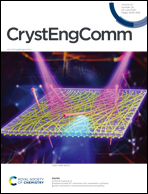A multifunctional photochromic metal–organic framework with Lewis acid sites for selective amine and anion sensing†
Abstract
An effective strategy for designing and synthesizing multifunctional materials incorporates functional organic moieties and metal ions or clusters using self-assembly. In this study, a multifunctional one-dimensional cationic metal–organic framework material based on Lewis acidic sites and the redox ability of a bipyridinium derivative has been successfully developed. Under UV-vis irradiation, [Eu(dpbp)2(H2O)4]·Cl (1) (H2dpbp·PF6 = 1-(3,5-dicarboxyphenyl)-4,4′-bipyridinium hexafluorophosphate) exhibits interesting reversible photochromic behavior with color changes that are visible to the naked eye. Because of the presence of Lewis acidic sites, 1 can be considered an excellent colorimetric sensor for the selective detection of amine vapors. At room temperature, 1 exhibits a strong red light emission, which endows it with good luminescence sensing ability for Cr2O72− anions. This work will motivate us to rationally design and synthesize more multifunctional materials based on bipyridinium derivatives which serve as practical multi-responsive materials to sensing light and chemicals.



 Please wait while we load your content...
Please wait while we load your content...